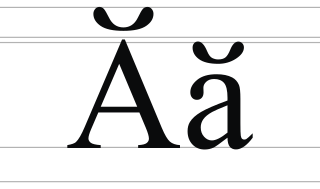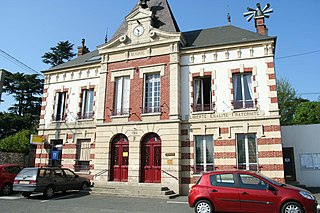In phonetics and phonology, a semivowel, glide or semiconsonant is a sound that is phonetically similar to a vowel sound but functions as the syllable boundary, rather than as the nucleus of a syllable. Examples of semivowels in English are the consonants y and w in yes and west, respectively. Written in IPA, y and w are near to the vowels ee and oo in seen and moon, written in IPA. The term glide may alternatively refer to any type of transitional sound, not necessarily a semivowel.

A breve is the diacritic mark ◌̆, shaped like the bottom half of a circle. As used in Ancient Greek, it is also called brachy, βραχύ. It resembles the caron but is rounded, in contrast to the angular tip of the caron. In many forms of Latin, ◌̆ is used for a shorter, softer variant of a vowel, such as "Ĭ", where the sound is nearly identical to the English /i/.

Ŭ or ŭ is a letter in the Belarusian Latin alphabet used since 1840/1845, based on u. It is also used in the Esperanto alphabet, publicly presented in 1887, and formerly in the Romanian alphabet. The accent mark (diacritic) is known as a breve.

Short I or Yot/Jot or I with breve, Russian: и с бреве) is a letter of the Cyrillic script. It is made of the Cyrillic letter И with a breve.

Alla breve – also known as cut time or cut common time – is a musical meter notated by the time signature symbol , which is the equivalent of 2
2. The term is Italian for "on the breve", originally meaning that the beat was counted on the breve.
Petrus de Cruce was active as a cleric, composer and music theorist in the late part of the 13th century. His main contribution was to the notational system.

Mensural notation is the musical notation system used for polyphonic European vocal music from the late 13th century until the early 17th century. The term "mensural" refers to the ability of this system to describe precisely measured rhythmic durations in terms of numerical proportions amongst note values. Its modern name is derived from the terminology of medieval theorists, who used terms like musica mensurata or cantus mensurabilis to refer to the rhythmically defined polyphonic music of their age, as opposed to musica plana or musica choralis, i.e., Gregorian plainchant. Mensural notation was employed principally for compositions in the tradition of vocal polyphony, whereas plainchant retained its own, older system of neume notation throughout the period. Besides these, some solely instrumental music could be written in various forms of instrument-specific tablature notation.

A with breve is a letter of the Cyrillic script. It may be a homoglyph of the Latin letter A with breve unless the typeface distinguishes between the Latin and Cyrillic breve.

Ye with breve is a letter of the Cyrillic script. In Unicode, this letter is called "Ie with breve".

Zhe with breve is a letter of the Cyrillic script created by Soviet linguists for the cyrillization of non-Slavic languages. Its form is derived from the Cyrillic letter Zhe by an addition of a breve.
Brèves is a commune in the Nièvre department in central France.

Bréval is a commune in the Yvelines department in the Île-de-France region in north-central France.
The tie is a symbol in the shape of an arc similar to a large breve, used in Greek, phonetic alphabets, and Z notation. It can be used between two characters with spacing as punctuation, non-spacing as a diacritic, or (underneath) as a proofreading mark. It can be above or below, and reversed. Its forms are called tie, double breve, enotikon or papyrological hyphen, ligature tie, and undertie.
Inverted breve or arch is a diacritical mark, shaped like the top half of a circle ( ̑ ), that is, like an upside-down breve (˘). It looks similar to the circumflex (ˆ), which has a sharp tip, while the inverted breve is rounded:.

Breves is a Brazilian municipality located in the state of Pará, on the island of Marajó. Its population as of 2020 is estimated to be 103,497 people. The area of the municipality is 9,550.454 km². The city belongs to the mesoregion Marajó and to the microregion of Furos de Breves.
Salvazaon is a genus of longhorn beetles of the subfamily Lamiinae, containing the following species:
Ya with breve is a letter of the Cyrillic script.
Yu with breve is a letter of the Cyrillic script.
![<span class="mw-page-title-main">O with breve (Cyrillic)</span> Cyrillic letter used for [ŏ] in Itelmen](https://upload.wikimedia.org/wikipedia/commons/thumb/1/18/Cyrillic_letter_O_with_breve.svg/320px-Cyrillic_letter_O_with_breve.svg.png)
O with breve is a letter of the Cyrillic script. In all its forms, it is a homoglyph of the Latin letter O with breve.

De with breve is a letter of the Cyrillic script. Its form is derived from the Cyrillic De by adding a breve.










![<span class="mw-page-title-main">O with breve (Cyrillic)</span> Cyrillic letter used for [ŏ] in Itelmen](https://upload.wikimedia.org/wikipedia/commons/thumb/1/18/Cyrillic_letter_O_with_breve.svg/320px-Cyrillic_letter_O_with_breve.svg.png)
